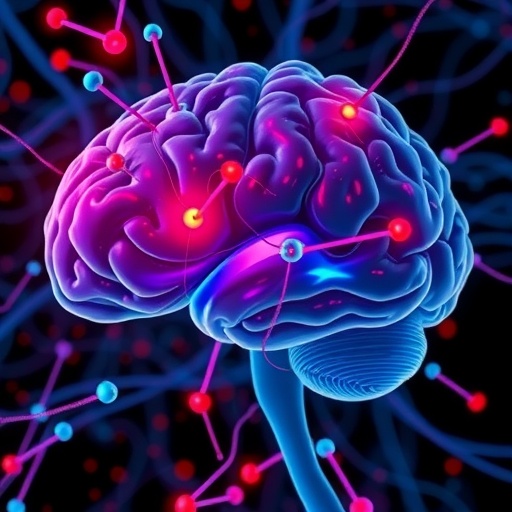Parkinson’s disease, a neurodegenerative disorder commonly associated with motor dysfunction, is now unveiling a more intricate impact on the brain’s cortical circuits than previously appreciated. A groundbreaking study by Minetti, Montagni, Meneghetti, and colleagues, published in npj Parkinson’s Disease, delves deep into the cellular and network-level disruptions caused by parkinsonism, focusing specifically on parvalbumin positive interneurons. These specialized cells, key modulators of cortical rhythms and neural synchrony, appear to be critically impaired, leading to a cascade of dysfunctions that underpin both motor and cognitive symptoms characteristic of the disease.
The cerebral cortex relies heavily on fine-tuned oscillatory activity to coordinate complex brain functions ranging from sensory processing to executive control. Parvalbumin positive interneurons (PV+ interneurons) are pivotal in generating and maintaining these oscillations, acting as gatekeepers of information flow and synchrony within cortical microcircuits. The study reveals that in parkinsonian states, these interneurons demonstrate profound dysregulation not merely at the synaptic level but extending through the network’s oscillatory architecture, effectively breaking down the brain’s temporal coding mechanisms.
Oscillations in the beta frequency range have long been implicated in the pathophysiology of Parkinson’s disease. However, Minetti et al.’s findings go a step further, illustrating that the disruption in parvalbumin interneuron activity alters not just amplitude or frequency, but also inter-neuronal coherence and phase relationships critical for optimal information processing. This suggests a synaptic and network-level breakdown that propels the pathological state beyond a simple loss of dopaminergic tone, pointing towards a more complex cortical dysfunction paradigm.
.adsslot_yOWkJupv8s{ width:728px !important; height:90px !important; }
@media (max-width:1199px) { .adsslot_yOWkJupv8s{ width:468px !important; height:60px !important; } }
@media (max-width:767px) { .adsslot_yOWkJupv8s{ width:320px !important; height:50px !important; } }
ADVERTISEMENT
An important aspect of this research lies in its methodological sophistication. Employing advanced electrophysiological recordings combined with optogenetic manipulations in animal models that replicate parkinsonian pathology, the team was able to isolate and characterize the specific perturbations in PV+ interneurons. They noted that these interneurons exhibited reduced firing rates and altered timing, leading to impaired feedforward and feedback inhibition within cortical networks. This loss of inhibitory precision could explain the exaggerated beta oscillations frequently observed in Parkinsonian patients.
Beyond oscillatory disturbances, the synaptic dynamics within PV+ circuits were found to be fundamentally compromised. Synaptic transmission efficacy suffered, characterized by decreased release probability and altered receptor composition at both excitatory and inhibitory synapses on these interneurons. Such synaptic plasticity changes likely erode the functional integrity of cortical inhibitory motifs, contributing to the broad spectrum of motor and non-motor symptoms through impaired cortical ensemble coordination.
Interestingly, the study also uncovered evidence implicating network-wide remodeling. Chronic parkinsonism induced compensatory but maladaptive changes in connectivity patterns involving PV+ interneurons, including aberrant synaptogenesis and dendritic remodeling. These structural alterations align with the notion of a progressively deteriorating cortical microenvironment where inhibitory interneuron dysfunction acts as a linchpin for cortical circuit failure.
Moreover, the identification of specific oscillatory and synaptic signatures linked to PV+ interneuron dysregulation opens the door for novel biomarker development. These biomarkers could be employed not only for early diagnosis but also for monitoring disease progression and therapeutic response, a crucial advancement in a condition notorious for its heterogeneity and diagnostic challenges.
The study’s revelations also contribute to a broader understanding of how neural oscillations govern brain health and disease. By dissecting the hierarchical disruption from synapse to network oscillations, Minetti and colleagues provide a compelling mechanistic narrative that bridges molecular alterations to system-level dysfunctions. This paradigm underscores the delicate balance maintained by inhibitory interneurons and its vulnerability in neurodegenerative diseases.
Furthermore, the research sheds light on the often-overlooked role of interneurons in neurodegeneration. While dopaminergic neurons have historically captured the spotlight, the focus on PV+ interneurons reveals a network-centric perspective, highlighting that neurodegenerative processes are distributed phenomena involving diverse cell populations and intercellular dynamics.
One cannot overlook the potential ramifications for cognitive symptoms of Parkinson’s disease, which remain poorly managed clinically. Given the central role of cortical oscillations in cognitive processes — including attention, working memory, and sensory integration — the dysregulation of PV+ interneuron function is likely a significant contributor to these deficits. Targeting these interneurons might thus address a critical unmet clinical need.
Minetti et al.’s work also poses intriguing questions about the interplay between subcortical pathology and cortical circuit disruption. While the basal ganglia are traditionally emphasized in Parkinson’s disease, the demonstrated cortical interneuron abnormalities suggest a more distributed network breakdown. Understanding how basal ganglia dysfunction propagates to cortical inhibitory circuits will be essential in constructing comprehensive models of Parkinsonian neurobiology.
The study’s use of cutting-edge technological approaches, including the integration of optogenetics with in vivo electrophysiology, sets a new standard for investigating circuit-level dysfunction in neurological disorders. Such approaches could be adapted to explore interneuron contributions in other conditions marked by oscillatory disturbances, such as epilepsy, schizophrenia, or Alzheimer’s disease, broadening the impact of this research.
In sum, this pivotal research reframes Parkinson’s disease as a disorder not only of dopamine deficiency but of cortical network instability driven by interneuronal dysregulation. The intricate portrait it paints of PV+ interneuron dysfunction advancing through synaptic and oscillatory domains underscores the complexity of brain rhythms in health and disease. As the neuroscience community digs deeper into these mechanisms, novel paths to treatment and diagnosis emerge, bringing new hope for those affected by this debilitating condition.
Subject of Research:
Parkinson’s disease impact on cortical function focusing on parvalbumin positive interneuron dysregulation
Article Title:
Parkinsonism disrupts cortical function by dysregulating oscillatory, network and synaptic activity of parvalbumin positive interneurons
Article References:
Minetti, A., Montagni, E., Meneghetti, N. et al. Parkinsonism disrupts cortical function by dysregulating oscillatory, network and synaptic activity of parvalbumin positive interneurons. npj Parkinsons Dis. 11, 194 (2025). https://doi.org/10.1038/s41531-025-01052-6
Image Credits: AI Generated
Tags: beta frequency oscillations in Parkinsonismcortical rhythm disruptionexecutive control and cortical microcircuitsimplications for sensory processing in Parkinson’sinterneuron dysregulation in parkinsonian stateskey modulators of neural synchronymotor dysfunction in Parkinson’s diseaseneurodegenerative disorders and brain circuitsoscillatory activity in the cerebral cortexParkinson’s disease cognitive symptomsparvalbumin positive interneurons dysfunctionstudy on Parkinson’s disease pathophysiology





